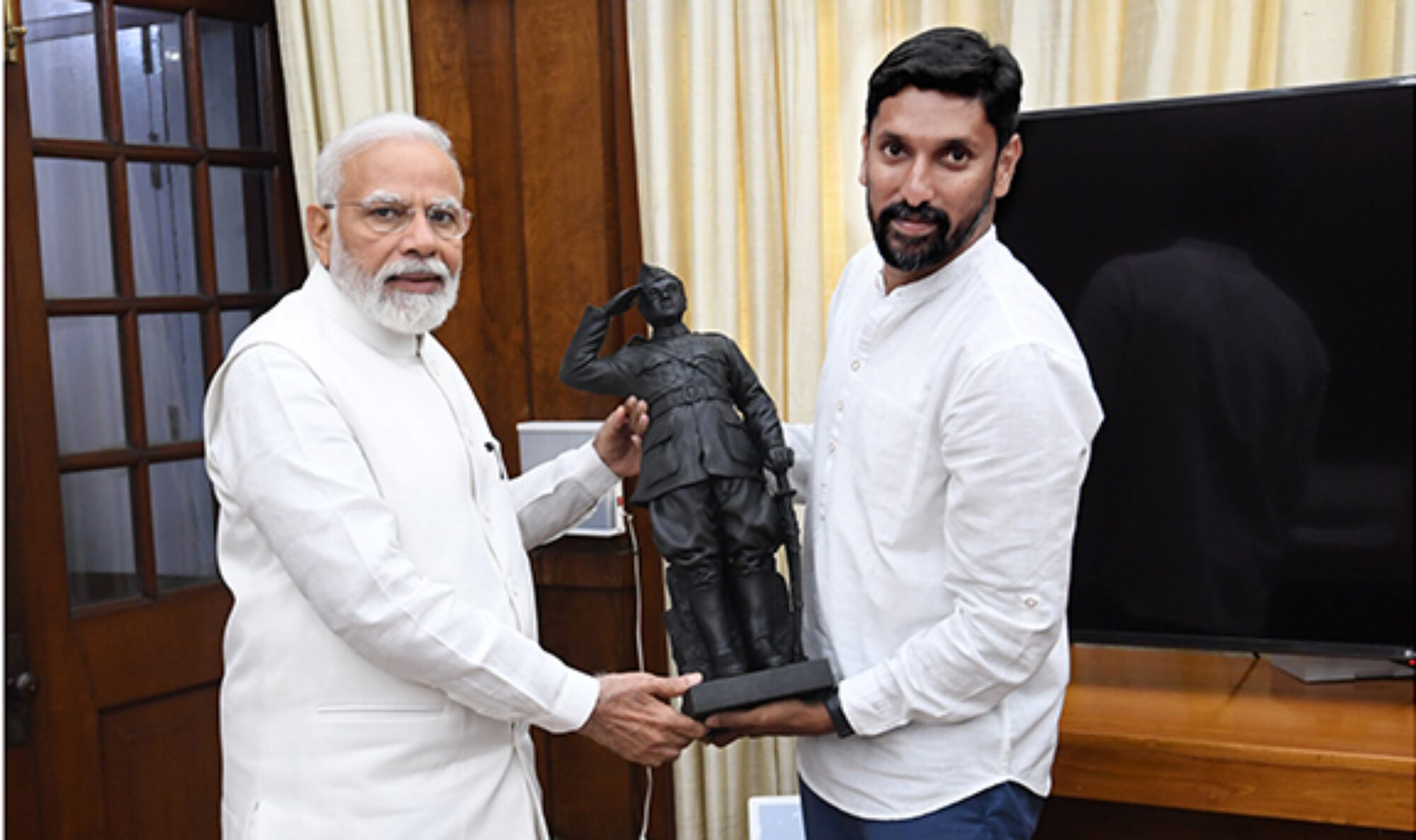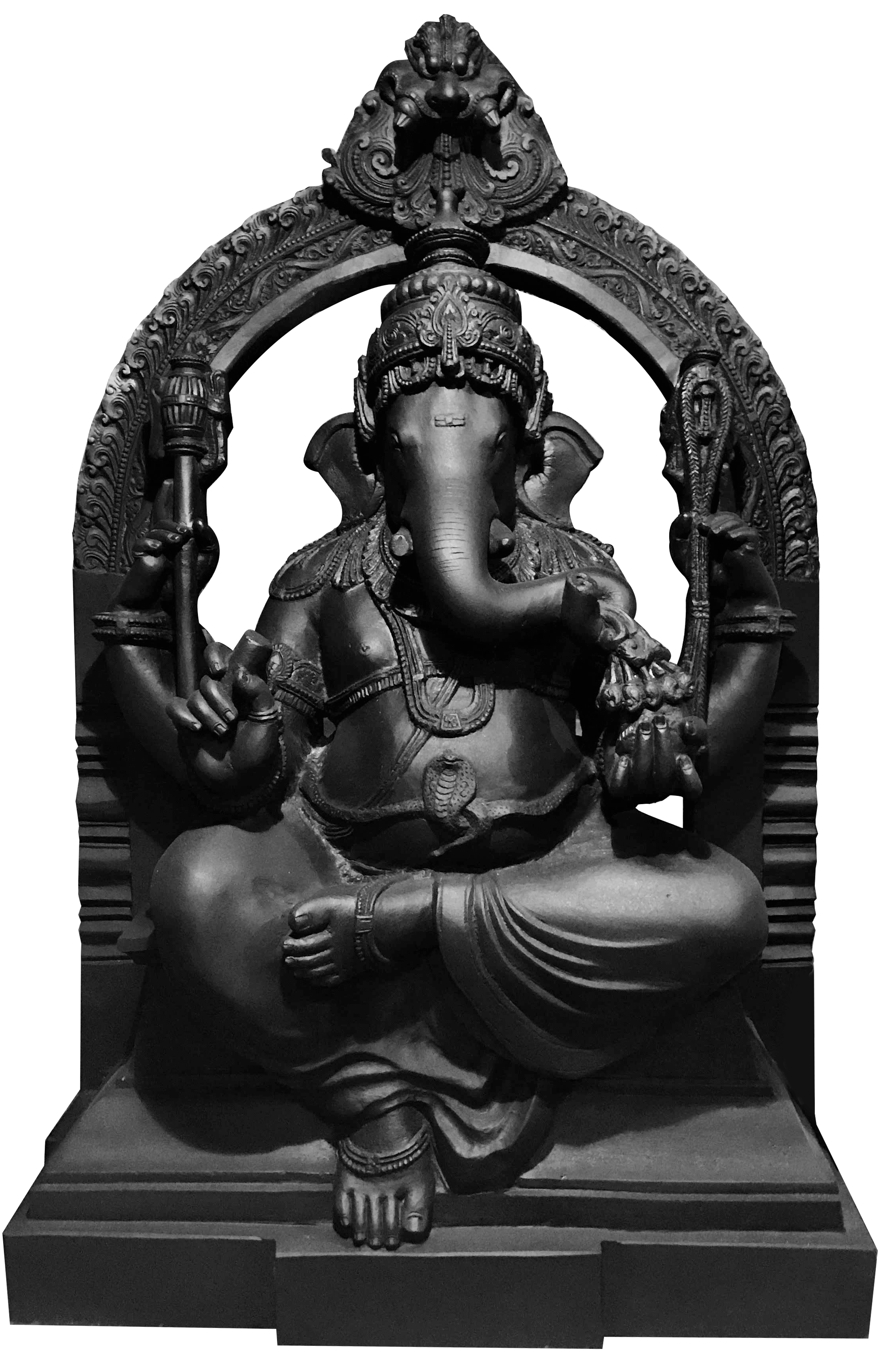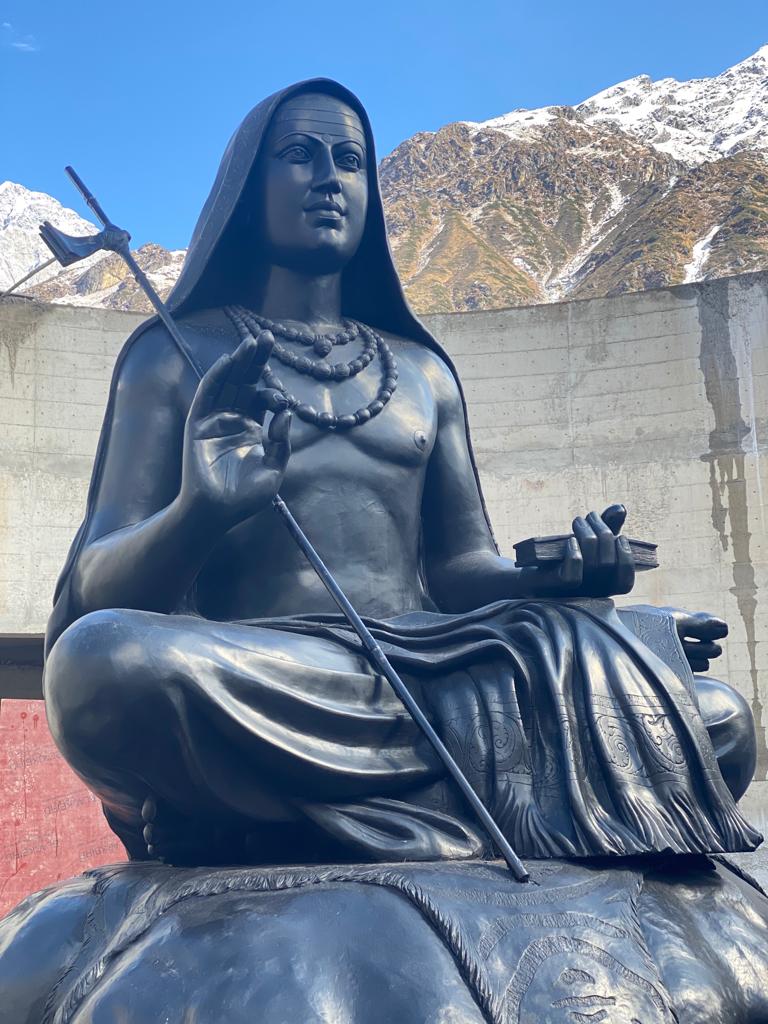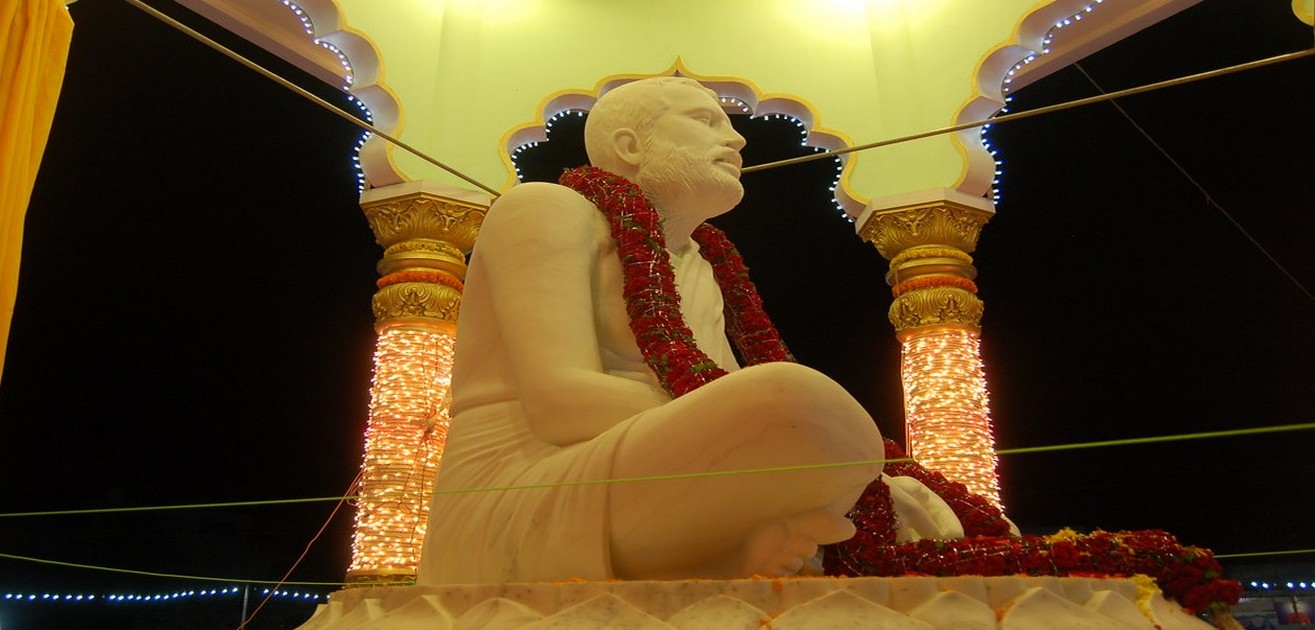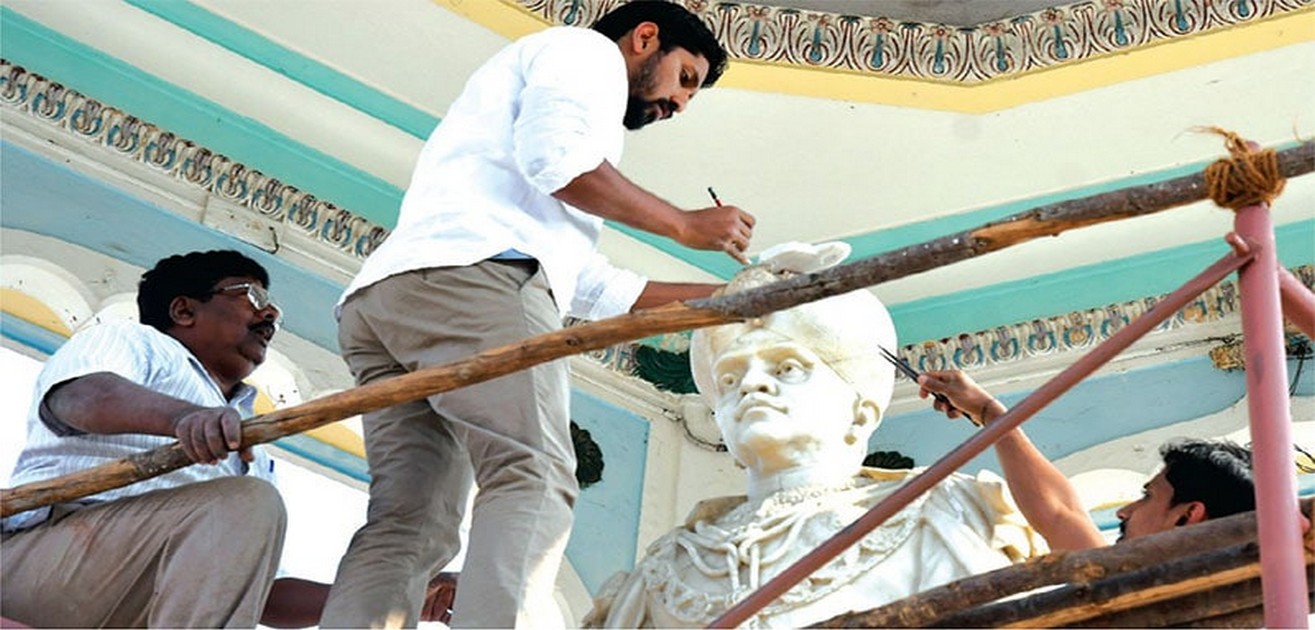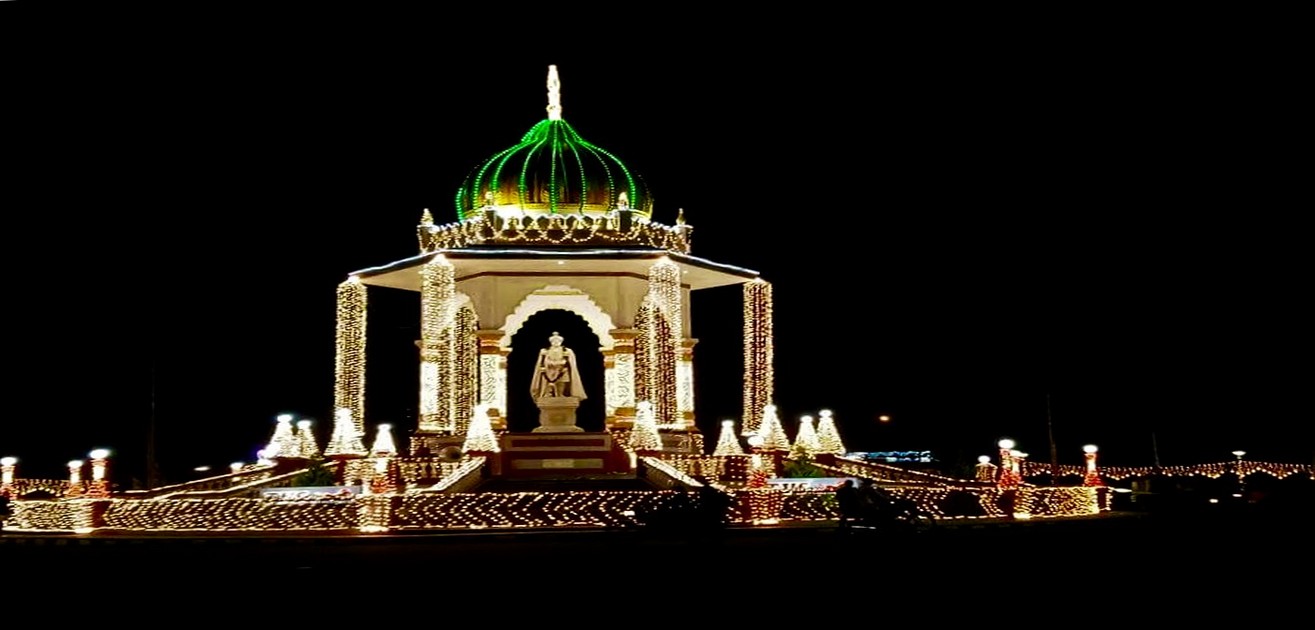Ganesha
Shankaracharya’s Statue in Kedarnath unveiled by Modi
Arun Yogiraj gave up his job to pursue the family tradition
When Prime Minister Narendra Modi unveiled the statue of Jagadguru Sri Adi Shankaracharya at Kedarnath on Friday the city-based sculptor Arun Yogiraj who watched the proceedings from Mysuru, was overcome with mixed feelings.
Though there was a sense of joy in having successfully completed the task, it was supplanted by grief over the recent death of his father – B.S.Yogiraj Shilpi – from whom he inherited the family tradition. His father was a recipient of many awards including the Amarashilpi Jakanachari award instituted by Karnataka Shilpa Academy and the Karnataka Rajyothsava award.
An MBA from the University of Mysore, Arun Yogiraj trained for six months in the HR Department of a private company. “But I listened to my inner voice and left the private sector job and returned to Mysuru to carry forward the family tradition,” he said.
He worked for nine months on the project and completed it in June. “I spent a month at Kedarnath for the installation of the statue but had to return a week ahead of the unveiling. Though everybody appealed to me to stay on for the unveiling by the Prime Minister, my mother’s health was sinking due to my prolonged absence and hence I returned home,” said Mr. Yogiraj.
Around the same time he had to be in Kedarnath, Mr. Yogiraj also won a project from Czech Republic but had to turn it down to complete the installation of Shankaracharya’s statue.
The statue was a labour of love and did not entail any difficulty though he worked on it for almost 14 hours daily for nine months. “The statue was transported by road for the most part and airlifted from Chamoli airbase by the IAF’s Chinook helicopter to Kedarnath,” said Mr. Yogiraj.
The black granite was procured from H.D. Kote and the raw material was originally 80 tonnes. After the completion of the project, the statue weighed 28 tonnes in all. In recognition of his contribution, district in-charge Minister S.T. Somashekar and others felicitated the sculptor at his residence on Friday.
But Arun Yogiraj is not resting on his laurels. He has another project on hand – a 25-feet tall monolithic statue of Anjaneya or Hanuman which will be installed at Chunchunkatte. He is looking forward to its completion.
Arun Yogiraj’s Common Man statue to be placed at the Malgudi
Arun Yogiraj is a fifth generation sculptor from Mysuru, whose latest is an ode to one of the most popular creations of the of the late cartoonist RK Laxman, The Common Man. Arun talks about the emotional connect with the sculpture and more…
Arun Yogiraj sculpts late actor Ambareesh
Mysuru-based sculptor Arun Yogiraj’s latest work is a bust of the late legendary actor Ambareesh, which is being installed at his birth place, Doddarasinakere near Mandya. Villagers and fans of the late actor had requested Arun to sculpt the bust in memory of Ambareesh, who passed away in November 2018. Speaking to us, Arun said, “I was actually nervous, as not many will get the offer to sculpt a bust of a famous personality. When I got this offer from his fans, I wanted to make it look as realistic as possible, or else it would have left his fans disappointed. They wanted the bust within 10 days of his passing, but since lot of creativity was needed, I asked for more time, to which they immediately agreed. Schist stone, the same rock used even in Belur and Halebidu, has been used to sculpt the bust. As most of his fans were impressed with the sitting portrait of Ambareesh that is in front of his samadhi, I took inspiration from it. The bust is around three feet high and weighs 700 kgs.”
Saral Jeevan – A Young And Talented Sculptor Of Mysore
Unveiling Of The Statue Of Sri Ramakrishna At Mysuru
Mysuru Urban Development Authority (MUDA) organised a programme on the occasion of the unveiling of the marble statue of Sri Ramakrishna. The statue was unveiled by the Chief Minister of Karnataka, Sri Siddaramaiah on 5 March 2018 at Sri Ramakrishna Paramahamsa Vritta in a prominent locality called Ramakrishna Nagara of Mysuru.
Sri Ramakrishna Paramahamsa Vritta (circle) is modeled in the same royal pattern as found in the monuments that adorn the circles that come within the city’s Core Heritage Zone. It is a typical structure that depicts the culture and beauty of Mysuru city which is acclaimed as the ‘heritage city’ and also as the ‘cleanest city’. Mysuru is well known for its spacious roads and gardens. Bedecked with many royal buildings and monuments it still retains a ‘royal charm’ and attracts thousands of tourists every day.
MUDA has the unprecedented prestige of naming its prominent localities as Ramakrishna Nagara, Sarada Devi Nagara, Vivekananda Nagara and Nivedita Nagara with some circles named as Chandramani Vritta, Gadadhara Vritta and the roads named as Dakshineshwara Marga, Kamarpukura Marga, Ananda Marga, Tyaga Marga, Jnana Marga, Moksha Marga, Vinaya Marga, Satya Marga, Daya Marga, Ahimsa Marga, etc. There are many gardens in the same area and they are named as Ramakrishna Paramahamsa udyanavana, Taaraka udyanavana, etc. In the Ramakrishna Paramahamsa udyanavana which is hardly five minutes by walk from the now unveiled statue, there is a kutiya with provision for devotees to sit and read The Gospel and also to sing bhajans, etc. Our devotees are already regularly meeting in this place to read and discuss the life of Sri Sri Thakur. Now, after the unveiling, all passers by and people of that area are paying their homage and it has brought about a festive and holy atmosphere in that area.
The spacious circle with the 10 feet tall marble statue of Sri Ramakrishna Paramahamsa sitting on a lotus and mounted on a round pedestral inside the dome-shaped monument has been carved by Sri Arun Yogiraj, a renowned sculptor of Mysuru who has sculpted many images of the Kings of Mysuru. He feels that this is his masterpiece and it has given him immense satisfaction.
The whole area was very well decorated with colorful lights and flowers. A huge rose garland was placed on the statue. Many cabinet ministers of Karnataka State, the Mayor of Mysuru, and other important corporation officials were also present. Monastic brothers of Mysuru and Swami Bodhaswarupananda of Ponnampet attended. The dignitaries and monks offered flowers to Sri Ramakrishna after the unveiling of a plaque and the statue and I performed a simple arati to Sri Thakur. A grand stage programme was organised and thousands of people participated in the event. Our Vidyashala boys sang the invocation.
The Chief Minister addressed the gathering and touched upon the spiritual greatness of Sri Ramakrishna, the service of Ramakrishna Mission in spreading value education and health, the accepting of all religions and faiths as valid paths, and the revival of Hinduism. He acknowledged that the Mysuru Ashrama gave shelter to Kuvempu who was imbued with the same principles as enunciated by Sri Ramakrishna and Swami Vivekananda. He also spoke about the contribution of Swami Vivekananda in spreading the spiritual heritage of India in the west.
Sri G T Deve Gowda, the local MLA from JDS also spoke on the significance of the life and message of Sri Ramakrishna. Swami Atmajnananda, Secretary, Ramakrishna Ashrama, Mysuru, highlighted the rising of Sri Ramakrishna beyond caste and religious barriers. A Carnatik classical programme by Dr Kadri Gopalnath, a renowned saxaphone player followed the stage programme. Sumptuous snacks and sweets were distributed to all those who attended the programme.
Unveiling of the statue of Sri Ramakrishna at Mysuru, March 2018
Sculptor pays novel tribute to Nalwadi Krishnaraja Wadiyar
Sculptor Arun Yogiraj paid a novel tribute to Nalwadi Krishnaraja Wadiyar by working round-the-clock to replace damaged metal pendants in the turban of the king’s Italian marble statue near the palace
MYSURU: Sculptor Arun Yogiraj paid a novel tribute to Nalwadi Krishnaraja Wadiyar by working round-the-clock to replace damaged metal pendants in the turban of the king’s Italian marble statue near the palace.
Krishnaraja Wadiyar was known for his development works and promotion of art and culture.
The king’s marble statue was installed in 1956 and was inaugurated by Sir M Visvesvaraya.
The Archives Department approached Yogiraj, grandson of renowned sculptor Basavanna who worked at Mysore Palace, after officials noticed damage to the turban which is inlaid with pearls and feathers.
Sculptor Yogiraj, along with three others, who had Italian marble pieces, worked on the design and carved the metal pendants, closely following the photographs provided by officials.
“We got it done. It took a day to fix the pendants on the turban of Nalwadi Krishnaraja Wadiyar’s statue,” Yogiraj said. He said they worked free of cost as the erstwhile Maharajas had supported his grandfather and encouraged his art work. He said statues of erstwhile Maharajas are poorly maintained. “As marble absorbs moisture, the white statue may lose its hue,” he said.
The work was supervised by Deputy Commissioner D Randeep and Archives deputy director Gavisiddaiah. Sculptor R K Kamath had carved Krishnaraja Wadiyar’s statue and Basave Gowda of KG Koppal had constructed the structure around it using marble which is the main attraction on New Sayyaji Rao Road and D Devaraj Urs Road Junction.
JC Wadiyar to stand tall at Hardinge Circle before Yaduveer’s royal wedding
The works on sculpting the statue of late Jayachamarajendra Wadiyar of erstwhile Mysuru Dynasty and proposed to be installed at Hardinge Circle in city is nearing completion.
The works have been put on fast track as it has been planned to unveil it in April before the wedding bell rings at the palace of Yaduveer Krishnadatta Chamaraja Wadiyar in the month of May. Instructions have also been given to complete the dome work by next month, where the statue of King, sculpted in white marble will be placed, said sources.
The statue was chiseled and brought to life by the noted sculptor, Arun Yogiraj who hails from a family of sculptors residing in Mysore for the past five generations. The statue was carved out of a monolithic white marble that was imported from Austria by a merchant in Jaipur, from where it was shipped to Mysore.
The statue of last ruler of Mysuru Royal Family when completed stands 10 feet tall, is 6 feet wide and stretches 4.5 feet, while the pedestal on which it is placed measures 5 feet in height and 4 feet in breadth. Arun, grand son of Palace Sculpture B Basavanna, accompanied by 9 other sculptors, has took five months to complete the statue, by working daily for more than 14 hours.“Before we begin sculpting, we do a detailed study of the anatomical and muscle structure of the person to be carved. Only after making notes right from shoes to the Mysore Peta, the ruler wore, we started the sculpting work. The earlier statutes of Chamaraja Wadiyar and Krishnaraja Wadiyar has been sculpted by artistes from London and Mumbai respectively, using Karora Marble of Italy. This is the first time Mysuru artistes has got the opportunity to sculpt a member of the Royal family, and am happy I got the opportunity,” he adds.
Arun, am MBA graduate !Like others he had dreamed of being well educated and joining an MNC company. His wish was fulfilled, but his destination was something else. Arun, an MBA graduate, after completion of education, joined an MNC company. But, he gave up his lucrative job to continue the tradition of stone carving.
One fine day, he realised he had to dedicate himself to sculpting and took it as a full profession from 2008. He has hired good number of people and has handful of orders.Arun who was assisting his father in sculpting work from the tender age, says: “I have good number of orders and am earning more than, what I would have been if gone for a salaried job. Through dedication, determination we can excel. I was very passionate towards filed and mastered the sculpting techniques,” he adds.
‘One of the best moment in life is meeting Kofi Annan, former United Nations Secretary-General during his visit to Infosys. He lauded my decision for continue the carrier in sculpture. The government should take initiatives to introduce a course in Temple Architecture and give practical training for students. The stone carving is entirely different and challenging compared to clay, wood carving,’ adds Arun, an fith generation sculpture.
He sculptures God and Godess idol, portrait statues, large sculpture works. He gets orders from Netherland, USA, Australia, Srilanka, UG, Germna and several parts of the country. Accompanied with his father Yogiraj Shilpi, he is running Kasyap Shilpa Kalanikethana a school of sculpture and providing training for interested youngsters.He is conducting classes for students of Shilpa Kala Academy and works as an consultant on concept of Sill Tourism for an Astralia based company. Arun has won several awards including Shilpa Kasturba Award, South Zone Young Talent Award and much more. Arun, an national-level volleyball players has represented Karnataka twice.
Stone Facts
The stones mostly used for creating idols is Krishna Sheele, which is available in this geographical area of HD Kote. The stone is resistant to Acid-fire-water-rust and all kinds of -weather and can withstand temperature upto 1200 degree.
While, the black granite is found in Chamarajanagar and Doddabalapura stone (worlds hardest stone) used for sculpting huge idols.
http://odysseyonapen.blogspot.com/2016/03/jc-wadiyar-to-stand-tall-at-hardinge.html
18 felicitated with district Rajyotsava award
Mysuru: Arun Yogiraj who sculpted the late Jayachamarajendra Wodeyar statue which has been installed at Hardinge Circle was among the 18 district Rajyotsava awardees who were felicitated for outstanding contribution in their respective fields by district minister HC Mahadevappa in front of Mysuru Palace here on Tuesday, November 1.
The statue was chiseled and brought to life by Arun Yogiraj, an MBA graduate who hails from a family of sculptors residing in Mysuru. Sand artist MN Gowri, an outstanding artist of sand art not only in the state but also across the country was also awarded the district Rajyotsava award.
Organisation: Neelakanta and Bogadi Siddegowda; Literature: TC Poornima and Jayappa Honnalli; Medicine: M Shivanna; Social Service: M Shivakumar; Folklore: Udigala Mahadevappa; Theatre: Honna Nayaka (Rural) and Borappa (Urban); Cleanliness: Paramesh and Venkatamma Heeraiah; Media: TV Rajeshwar; Music: Sunita Chandrakumar and M Shivakumar; Art: Arun Yogiraj and MN Gowri; Pro Kannada activists: K Madesh and S Balakrishna.
https://www.newskarnataka.com/mysore/18-felicitated-with-district-rajyotsava-award
Carving the future of sculptures
Brothers-in-arms – Arun and Suryaprakash are working towards providing knowledge on art of carving sculptures at their workshop in order to keep tradition alive, writes Manish
Where the spirit does not work with the hand, there is no art. – Leonardo Da Vinci, Italian sculptor.
When Arun completed his MBA in HR from a reputed institute, he had decided on his future. The lure of private multinational companies wasn’t meant for him. His goal was different.
He wanted to follow in the footsteps of his ancestors, who have carved several sculptures that can be seen all around the city. Giving him support was his brother Suryaprakash and father Yogiraj Shilpi.
At his workshop, which is located diagonally opposite to Sanskrit Paatashaala, Arun and Suryaprakash have several artisans working on creating various sculptures. Reminiscing about the works carried out by his grandfather – P Basavanna Shilpi – Arun says that the former had carved 64 idols for the Amba Vilas Palace in just 11 months for which the then Maharaja Jayachamaraja Wadiyar had given him a ‘Belli Suthige’ (silver hammer). The Bhuvaneshwari and Rajarajeshwari idols inside the Amba Vilas Palace is also the handiwork of Basavanna Shilpi, he adds.
The statue of Jayachamaraja Wadiyar inside Sri Chamarajendra Zoological Gardens was done by his father. His creation was a seven feet idol of Yoganarasimhaswamy consecrated at Saligrama in Mysore district recently. He said the work was completed within 24 days, which is considered to be as Ardhamandala – an auspicious sign.
Arun mentioned that many know the theoretical aspects of sculpting, but don’t know how to implement it practically. With this in mind, Arun is planning to set-up a website in order to provide people information about carvings.
Also free classes would be held if anybody is interested in learning the art. “Many people in Tamil Nadu are making efforts to keep their tradition alive.
But, in Karnataka art forms are slowly disappearing,” he says. Earlier, a few foreigners, who had come to the city to learn Yoga, had also spent nearly
two months with his father in order to learn the traditional methods of sculpting. He mentioned that he is now providing practical classes to students who have enrolled for sculpture related course at Karnataka State Open University. Last year 11 students had participated in the practicals in his workshop, he adds.
“We specialise in Mysore style of sculpting. Many of the people outside Mysore immediately recognise our style. But those in the city rarely recognise it,” he says sadly. “The Mysore style is an improvisation of the methods used in Hoysala architecture,” he adds.
He recollects that one of the sculptures – Darpana Sundari – given by his grandfather to Nehru is an example. The statue of a ‘Darpana Sundari’
doesn’t have a frame to support it.
With Arun and Suryaprakash taking the mantle of passing knowledge and secrets of sculpting to the next generation, Mysore can hopefully retain its
traditional sculptures. Some of the idols sculpted by Arun and Suryaprakash’s family:
Eight Dwarapalakas at the Amba Vilas Palace.
Gnanachakra – in front of the Crawford Hall of University of Mysore.
Shankaracharya statue at Kollur Mookambike Temple.
20 idols based for Kamakameshwari Temple in Japan.
Kaveri idol at Harangi Dam.
Idols at Kannikka Parameshwari Temple at Sajjanrao Circle in Bangalore, Shaneshwara Temple at Rajajinagar in Bangalore and Mathikere Chowdeshwari Temple.
Carving the future of sculptures
https://www.deccanherald.com/content/231571/carving-future-sculptures.html
